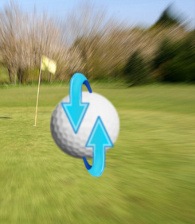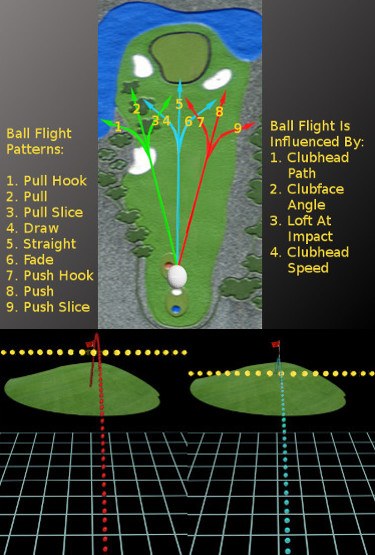
It's the label every golfer aspires to: shotmaker.
Ben Hogan was a shotmaker. Sam Snead too. Same for Seve Ballesteros and Lee Trevino.
What separates a shotmaker from mere golfers? Simply, the ability to shape shots left or right, hit them high or low and precisely control distance, all on command as the situation requires.
What does it take to become a shotmaker? The basic ingredients include:
- A fundamental knowledge of spin and loft and their effects on the ball's flight. For example, left-to-right sidespin causes the ball to curve in the same direction.
- An understanding of how to impart different types of spin on the ball. The ball flies left to-to-right, for instance, when the club's face is open relative to its path at impact. Also, positioning the ball farther right in the stance decreases the club's effective loft, producing a lower trajectory.
- A sound swing in which the clubhead approaches the ball from just inside or directly on the target line.
- Lots and lots of practice.

Shotmaking is primarily about angles. Learn the cause and effect of different alignments, clubhead aim and ball position and you'll own the knowledge to become a shotmaker.
In golf, the term 'shotmaker' refers to a player who is capable of producing a variety of different shots based on the situation at hand.

The advantage of being a shotmaker is obvious – rather than trying to use the same ball flight in every situation, you can tailor your approach to match the demands of the course. For instance, you can curve the ball to the left in order to access a hole location which is cut on the left side of the green, or you can do the opposite when the hole is cut on the right. It is not easy to become a shotmaker, as there is plenty of practice involved, but your game will be dramatically improved if you can place yourself in this category.
This article is going to provide you with some advice on how to move yourself closer to earning the unofficial title of shotmaker. However, before you even embark on such a journey, you need to make sure you are ready for the challenge. As a starting point, you should have reasonable control over your standard ball flight, and you should be able to repeat your swing nicely from shot to shot. That doesn't mean you hit perfect shots every time – no one does that – but it does mean that your standard swing is fairly reliable. If you haven't yet reached that point, keep working on your basic technique and revisit the idea of being a shotmaker when your game has taken a step forward.
It should be noted that shotmaking abilities do not have to apply only to full swings. In fact, some of the most impressive shotmaking you will ever see on the golf course takes place around the greens. The short game presents you with a number of different challenges during each round, so having numerous shots available to meet those challenges is a big advantage. Later in the article, we will talk specifically about ways you can develop your shotmaking ability in the short game.
All of the advice below is written from the perspective of a right-handed golfer. If you play left-handed, please take a moment to reverse the directions as necessary.
Three Basic Shots

When you step up to hit a golf shot, there are nearly endless possibilities for how that ball will fly through the air. It can turn left or right, fly high or low, and just about anything in between. One of the things that makes golf such an interesting and enjoyable game is the variety that it presents. Each trip to the course is a chance to see or do something new. This is one of the main reasons that so many golfers stick with this game for a lifetime.
As you work toward becoming a better shotmaker, it is easy to get overwhelmed with the sheer number of different shots you could attempt. To help bring some focus to this process, we are going to suggest that you work on three specific shots to get started. You may want to add others to your game later on, but starting with the three listed below is a good plan.
- An opposite curve. For starters, you are going to work on learning how to curve the ball in the opposite direction of your normal pattern. So, if you usually hit a draw, you are going to work on hitting a fade. Or vice versa. This skill is at the heart of being a shotmaker. Unfortunately, most amateur golfers do not have the ability to curve the ball both directions on command. In fact, many amateurs are happy if they can just produce their standard shot on a regular basis. We think you should set your sights a little higher. By learning how to hit both a fade and a draw on command, you will be prepared to successfully handle far more situations on the course.
- A high shot. When you make your standard swing, the ball is going to fly on a certain trajectory based on factors like swing speed, spin rate, and the club you are using. Your standard trajectory should work for many shots, but it is not always going to be the best option. With that in mind, it is good to be able to hit a higher-than-normal shot when necessary. This is a shot that will come in handy when the greens are firm, for example, as you'll be able to stop a high shot quicker than a low shot. Modern-day golf equipment is designed to make it easy to hit the ball high, so learning this shot is not nearly as difficult as it used to be.
- A low shot. On the other end of the spectrum, it is also valuable to have the ability to hit a low shot when the time is right. The most common reason to use a low shot is to avoid the wind, but there are other circumstances where you may want to put this type of trajectory into action. As you might guess, that same equipment that makes it easier to hit the ball high also makes it a little tougher to produce a low shot. Punch shots are not as easy as they once were, but they are certainly still possible. Once you learn how to produce a reliable low shot, you may be surprised to find just how often this trajectory comes in handy.
That's it – just three shots, but a whole new world of possibilities on the course. If you can get comfortable with each of these three shots on the driving range, you can start to put them into action on the course sometime soon. In the next section, we are going to discuss some technical adjustments you can use to make these alternative ball flights possible.
Before we move on to the next section, however, we need to have a quick talk about course management. As you learn new shots, you'll need to learn how to use those shots intelligently. It would be a mistake just to use them because you have them – they should only be put into action when they will actually benefit your game. In other words, you don't want to force the issue. Keep an open mind as you make your way through a round, and always play the shot that you think gives you the best possible chance at a successful outcome.
Making Technical Adjustments

At this point, we are going to get down to the business of helping you hit these new shots. It's all great in theory to plan on adding shots to your repertoire, but the reality of making this happen is challenging, to say the least. Even if you are highly comfortable and confident with your current golf swing, causing the ball to behave in new ways is going to test your abilities.
Of course, we can't tell you exactly the changes you will need to make to hit each kind of shot, because we've never seen you swing the club. Every player is different, and the precise changes necessary are going to vary somewhat from golfer to golfer. So, in this section, we are going to offer some general tips that we hope will point you in the right direction. Experiment with these tips, and any other adjustments you feel may be necessary, until you start to get the desired results.
- Turning your grip. One of the best ways to alter the pattern of your ball flight is simply to turn your grip at address. If everything else in your swing remains the same, turning your grip in one direction or the other should help you to create the desired ball flight. When you want to turn the ball to the left, you are going to use a stronger grip. To encourage a ball flight that turns to the right, you will weaken your grip. As a reminder, strengthening your grip involves turning your hands to the right as you are looking down from address, and weakening your grip means you will rotate them to the left. A handy way to remember how this works is to think in terms of opposites. If you want the ball to turn farther left, rotate your hands to the right on the grip. For a shot that turns more to the right, rotate your hands to the left. It should be noted that grip adjustments are notoriously difficult, especially at first. If you try this out on the driving range, you're likely to find that your swings are uncomfortable and the results are disappointing. That's okay – you need to stick with it. At some point, you'll start to get more comfortable with the way your swing feels while using different grip positions, and the results you see will improve.
- Adjusting your stance. This is another way you can influence the path of your ball flight in terms of right and left. And again, you will need to think in terms of opposites to get the pattern you desire. When you want to hit a draw – a shot that turns to the left – you will close your stance, meaning your feet will be aimed out to the right. Or, when you want to hit a fade, you will open your stance and your toe line will be directed to the left of the target. Golf is frequently a game of opposites, and we have seen that to be the case with these first two points. Altering your stance works nicely for changing your ball flight because it is going to influence the path the club takes through the ball. As long as you swing along your foot line going through impact, you are going to be able to create the spin needed to generate a specific ball flight. This is a particularly effective tip for those who usually play a fade and want to be able to turn the ball over to the left from time to time.
- Altering your ball position. When it comes to hitting shots higher or lower, ball position is crucial. The placement of the ball in relation to your stance is going to have a lot to do with the final trajectory of the shot. Fortunately, this is not one of those times where you have to think in terms of opposites. Instead, this one works exactly as you would expect. If you want to hit the ball higher, you need to move the ball up in your stance. If you want to hit it lower, you need to move it back. It's just that simple. Of course, you will need to practice these adjustments, since moving your ball flight is going to change your point of contact at the bottom of the swing. It will take a little practice to get comfortable with using different ball positions, but this is one of the easier adjustments to learn.
It is unlikely that you will be able to hit all of the shots you'd like to have in your bag just by using the changes listed above. There is a lot that goes into producing any specific ball flight, and you'll need to invest quality time on the range before you can call yourself a shotmaker. We hope these tips get you started in the right direction, however. The driving range is the perfect place to experiment with various swing changes, as you can simply load up a new ball if the first swing didn't work as expected. The golfer who is willing to experiment with technical changes on the range is more likely to find new shots that can actually be used on the course.
To finish up our article on shotmaking, we want to touch on a few miscellaneous tips.
- Trust yourself. As you add more and more shots to your arsenal, you will be tempted to try playing every single shot 'by the book'. That means you'll feel like you have to hit a draw off the tee when playing a dogleg left, and a fade when playing a dogleg right. Or, you might think you have to draw the ball into a left-hand hole location, and do the opposite when the hole is cut on the right. Remember, you have the ability to use whatever shot you feel is going to be most successful. Trust your 'gut instinct' here and go with the shot that gives you the most confidence. If that means going against conventional wisdom from time to time, so be it.
- Be patient. Don't rush to put your new shots into action on the course. They might be working okay on the driving range, but that doesn't mean they will automatically perform well during a round. Make sure you spend plenty of practice time with your new shots before they make an appearance on the links.
- Always commit. There is no room for doubt in the game of golf. Once you have decided to use a particular ball flight in a given situation, trust that decision to focus on executing the swing to the best of your ability. If there is any doubt hanging in the back of your mind, you are destined for failure. Don't walk up to the ball to take your stance until you have fully committed to your choice.
Working on your shotmaking skills can bring a whole new level of enjoyment to your practice sessions. It is fun to teach yourself how to make the ball behave in new ways, and you might be surprised to find what you are capable of achieving. Then, when you start to use these shots on the course, you will see how much room you have for improving your scores thanks to this expanded repertoire of shots. Good luck!






